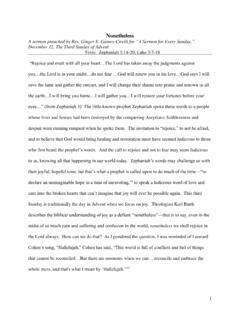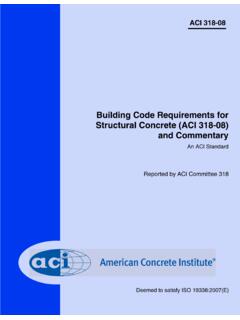Transcription of What Is Realism, and Why Should Qualitative Researchers Care?
1 33 1 What Is Realism, and Why Should Qualitative Researchers Care? Realism Philosophic realism in general is defined by Phillips (1987, p. 205) as the view that entities exist independently of being perceived, or independently of our theories about them. Schwandt adds that scientific realism is the view that theories refer to real features of the world. Reality here refers to whatever it is in the universe ( , forces, structures, and so on) that causes the phenomena we perceive with our senses (1997, p. 133). Such views were ignored or disparaged during much of the twentieth century, both by positivists and by constructivists and other antipositivists. However, they have emerged as a serious position in current philosophical discussion (Boyd, 2010; Devitt, 2005; Niiniluoto, 2002; Putnam, 1987, 1990, 1999; Salmon, 2005).
2 In the philosophy of science, including the philosophy of the social sciences, realism has been an important, and arguably the dominant, approach for over 30 years (Baert, 1998, pp. 189 190; Hammersley, 1998, p. 3; Suppe, 1977, p. 618); realism has been prominent in other areas of philosophy as well (Miller, 2010). There are ongoing philosophical debates over realism that remain unre-solved, and realist philosophers themselves disagree about many of these issues; one advocate of realist views claimed that scientific realism is a majority posi-tion whose advocates are so divided as to appear a minority (Leplin, 1984, p. 1).However, equally serious issues confront alternative positions, and the idea that there is a real world with which we interact, and to which our concepts and 4 PART I A REALIST STANCE FOR Qualitative RESEARCH theories refer, has proved to be a resilient and powerful one that has attracted increased philosophical attention following the demise of positivism.
3 In the social sciences, the most prominent manifestation of realism is the critical realist tradition usually associated with the work of Roy Bhaskar (1978, 1989, 2011; Archer, Bhaskar, Collier, Lawson, & Norrie, 1998; Manicas, 2006; Sayer, 1992, 2000). However, Bhaskar s work, particularly his more recent development of critical realism as an emancipatory perspective, which he called dialectical critical realism, departed in significant ways from the position I take here, and has been criticized by others in the critical realist tradi-tion ( , Pawson, 2006 1 ; , accessed 11/2/2009). I have therefore not adopted Bhaskar s views in general, although I find his basic positions (particularly on the importance of distinguishing ontol-ogy from epistemology) compatible with the stance that I present here.
4 My position draws substantially from other versions of realism that I see as compatible with the key ideas of the critical realist tradition, and that pro-vide additional insights and alternative perspectives for using realism in quali-tative research. These include the work of the social scientist Donald Campbell (1988) and the philosophers Cartwright (1999, 2007), Davidson (1980, 1993, 1997), Haack (1998, 2003), Little (1991, 1995/1998, 2010), McGinn (1999), Putnam (1990, 1999), Salmon (1984, 1989, 1998, 2005), and Wimsatt (2007); the physicist Barad (2007); the linguist Lakoff (1987; Lakoff & Johnson, 1999); the evaluation Researchers Pawson and Tilley (1997; Pawson, 2006) and Henry, Julnes, and Mark (1998; Mark, Henry, & Julnes, 2000); and the quali-tative Researchers Huberman and Miles (1985; Miles & Huberman 1994) and Hammersley (1992a, 1998, 2002, 2009).
5 A wide range of terms have been used for such versions of realism, including critical realism (Archer et al., 1998; Bhaskar, 1989; Campbell, 1974, 1988; Cook & Campbell, 1979), experiential realism (Lakoff, 1987), constructive (and, later, perspectival ) realism (Giere, 1999), subtle real-ism (Hammersley, 1992a), emergent realism (Henry, Julnes, & Mark, 1998; Mark, Henry, & Julnes, 2000), natural realism (Putnam, 1999), innocent realism (Haack, 1998, 2003), and agential realism (Barad, 2007); Wimsatt (2007) didn t give his approach to realism a formal name, but used the phrase 1 Pawson (2006) aligned himself with Campbell s rather than Bhaskar s version of critical realism: It is the critical element that causes the confusion.
6 Campbell is a critical realist in a quite, quite different sense from Bhaskar and his emancipatory colleagues. For Bhaskarians criticism is warranted on the basis of the analyst s privileged under-standing of the oppressive aspects of the social condition and those responsible for it. For Campbell, criticism is something that scientists apply to each other. (p. 20) Chapter 1 What Is Realism, and Why Should Qualitative Researchers Care? 5 multi-perspectival realism (p. 12) to describe this. I will use the term critical realism in a broad sense to include all of these versions of realism. 2 A distinctive feature of all of these forms of realism is that they deny that we can have any objective or certain knowledge of the world, and accept the possibility of alternative valid accounts of any phenomenon.
7 All theories about the world are seen as grounded in a particular perspective and worldview, and all knowledge is partial, incomplete, and fallible. Lakoff states this distinction between objectivist and realist views as follows: Scientific objectivism claims that there is only one fully correct way in which reality can be divided up into objects, properties, and relations.. Scientific realism, on the other hand, assumes that the world is the way it is, while acknowledging that there can be more than one scientifically correct way of understanding reality in terms of conceptual schemes with different objects and categories of objects. (1987, p. 265) As Frazer and Lacey put it, Even if one is a realist at the ontological level, one could be an epistemological interpretivist.
8 Our knowledge of the real world is inevitably interpretive and provisional rather than straightforwardly repre-sentational (1993, p. 182). Critical realists thus retain an ontological realism (there is a real world that exists independently of our perceptions, theories, and constructions) while accepting a form of epistemological constructivism and relativism (our understanding of this world is inevitably a construction from our own perspec-tives and standpoint). The different forms of realism referenced here agree that there is no possibility of attaining a single, correct understanding of the world, what Putnam (1999) describes as a God s eye view that is indepen-dent of any particular viewpoint.
9 This position has achieved widespread, if often implicit, acceptance as an alternative both to na ve realism and to radical constructivist views that deny the existence of any reality apart from our constructions. Shadish, Cook, and 2 Bhaskar did not initially use the term critical realism for his position, calling his philo-sophical views transcendental realism and his extension of these to the social sciences critical naturalism. The phrase critical realism, used previously by other philosophers with different meanings (Groff, 2007, p. 4), was first suggested by others in the Bhaskarian tradition, and then adopted by Bhaskar ( ). It isn t clear whether this suggestion was influenced by Donald Campbell s earlier use, in presenting his theory of what he called evolutionary epistemology, of the phrase criti-cal realism ( , 1974/1988, p.)
10 432; Cook & Campbell, 1979, pp. 28 30) to refer to the linking of ontological realism and epistemological relativism (1988, pp. 440 450), a posi-tion that is central to Bhaskar s views. Since Campbell s use has historical priority, I will use the term critical realism in a broad sense to include a range of positions incorporat-ing this view, including Bhaskar s. 6 PART I A REALIST STANCE FOR Qualitative RESEARCHC ampbell (2002) argued that all scientists are epistemological constructivists and relativists in the sense that they believe that both the ontological world and the worlds of ideology, values, etc. play a role in the construction of sci-entific knowledge (p. 29). Conversely, Schwandt, in his SAGE Dictionary of Qualitative Inquiry (2007), stated that on a daily basis, most of us probably behave as garden-variety empirical real-ists that is, we act as if the objects in the world (things, events, structures, people, meanings, etc.















